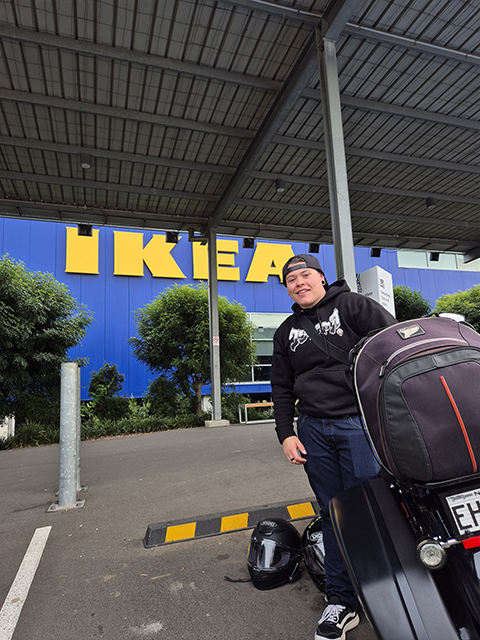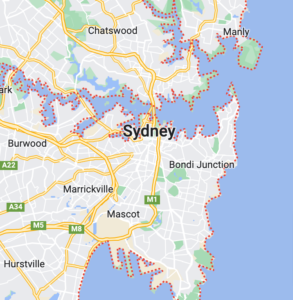As our rider said, “it was a perfect winter trike tour”. As our passengers wrote, “We had a wonderful time …” The rest of the review we will put up tomorrow.
Our passengers flew in from New Zealand this morning. The trike rider picked them up from their hotel in Mascot, near the Sydney International Airport. From there they rode to La Perouse, about 14 km southeast of the Sydney CBD.
La Perouse
This beautiful peninsula in Sydney’s southeast is where Captain Arthur Phillip’s First Fleet initially landed in 1788, before deciding to settle at Sydney Cove. La Perouse is named after a French explorer who arrived in Botany Bay a week after the First Fleet. Nearby is the 1880s-built Bare Island Fort, which you might recognise from the Tom Cruise film Mission Impossible 2.
Then they headed north.
Little Bay
The little known Little Bay area was first used as a sanitation camp during Sydney’s smallpox outbreak in 1881–82, to isolate the healthy contacts of sufferers of the disease. Also, bubonic plague in Sydney of 1900 and then again when soldiers returning from Europe brought the influenza virus back in 1919. Little Bay was an ideal location because it was isolated from settlements but still close enough to Sydney
Long Bay Correctional Complex (Gaol)
Next, they rode past the notorious Long Bay Goal. The State Reformatory for Women was opened in 1909 and the State Penitentiary for Men was opened beside it in 1914. Gallows were in operation at the complex from 1917 to 1939. The Long Bay Correctional Complex, commonly called Long Bay, is a correctional facility comprising a heritage-listed maximum and minimum security prison for males and females and a hospital to treat prisoners, psychiatric cases and remandees.
Maroubra
Riding further north, Maroubra is one of Australia’s top surfing beaches. It is a local Aboriginal word meaning place of thunder. In 2006, Maroubra Beach became the second Australian beach to be named an official National Surfing Reserve. The spectacular 1km long beach is wrapped by a rocky headland and natural bushland.
Coogee
Then, they rode to both the south and north end of Coogee Beach. At the southern end is Wylies baths (open 365 days a year), as well as McIver’s Baths, which is the only remaining female-only ocean pool in Australia (dating back to 1886).
😆 The name Coogee is derived from the Aboriginal word ‘koojah’ which means ‘bad smell’ or a ‘stinking place’. Already, the perfect winter trike tour in Sydney was showing beautiful yet interesting areas which most visitors don’t see.
Clovelly Beach
Further north to Clovelly Beach. Clovelly Beach is a small and tranquil beach, located the mouth of a narrow bay between two rocky ridges.
Bronte
Then, they rode yet further north to Bronte Beach. Bronte Beach sits on Nelson Bay, surrounded by Bronte Park. Bronte offers scenic cliff-top walking paths south to Coogee via the Waverley Cemetery and north to Tamarama and Bondi Beach.
Tamarama
Riding south, along more beautiful, though possibly less well known, beaches. The suburb of Tamarama has a small ocean beach about 1 km south of Bondi Beach and a couple of hundred metres north of Bronte Beach. It is an extremely narrow beach and deceptive for its size. Tamarama Beach is often referred to as Glamarama (or Glamourama), owing to the alleged abundance of glamorous people who sunbathe (often topless), on what must be one of the smallest strips of sand in the state (Wikipedia).
Bondi Beach
Next, they drove past the world famous Bondi Beach, to the south and middle. This is the beach where Bondi Lifeguards of the Bondi Rescue TV series is filmed. When in Sydney it is one of the places you should visit. The beach is seriously nice (but not our favourite) but it’s good to say you have seen it – even in the rain 😊. Bondi Beach is one of the most visited tourist sites in Australia. Bondi Beach is recorded by the Australian Museum that Bondi means place where a fight using boondi sticks (nullas nullas or fighting sticks) took place.
They stopped near the Lifeguard Tower to have a look and take photos. They also stopped at the famous Bondi Icebergs and swimming pool.
Eastern suburbs
Continuing on, they headed west through the posh suburbs of the eastern suburbs of Sydney, including the Bays: Rose Bay, Double Bay and Rushcutters Bay. The passengers on the perfect winter trike tour have seen so many beautiful places.
Macquarie Street
Next, they rode up Macquarie St. This street, is the location of the main governmental institutions of NSW: Parliament House, Government House, and the Law Courts Building (which houses the Supreme Court of New South Wales). There is so much history behind Macquarie St. and the buildings that front it.
In the years since its founding in 1788, Sydney had developed organically, and by the early 1800s was lacking in major public buildings, and had a complex network of narrow streets. The supply of drinking water and waste management was also becoming an issue. Governor Macquarie initiated the construction of Sydney’s first public buildings of any real permanence and set the boundaries of Sydney’s grid of streets, laying out the street in 1810.
Opera House
Finally, they rode on the Cahill Expressway and past the iconic Sydney Opera House. We can’t ride close but you can see it from a different angle to the usual. The Sydney Opera House is a multi-venue performing arts centre. Designed by Danish architect Jørn Utzon, but completed by an Australian architectural team headed by Peter Hall, the building was formally opened by Queen Elizabeth II on 20 October 1973.
In conclusion, the perfect winter trike tour in Sydney was a fun and memorable experience. Feel the Freedom!
or just email trevor@trolltours.com.au and tell us what you would like to do.




